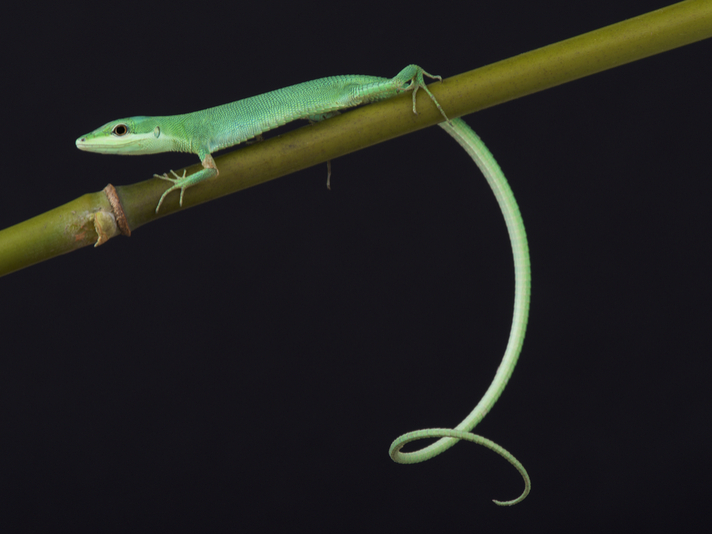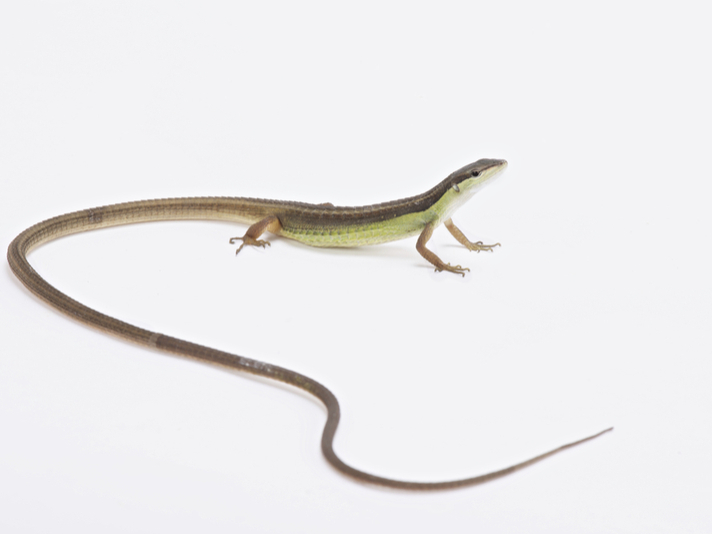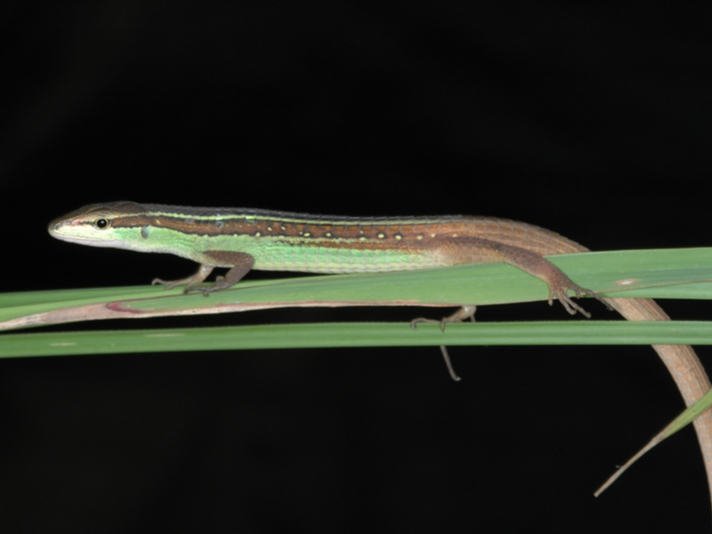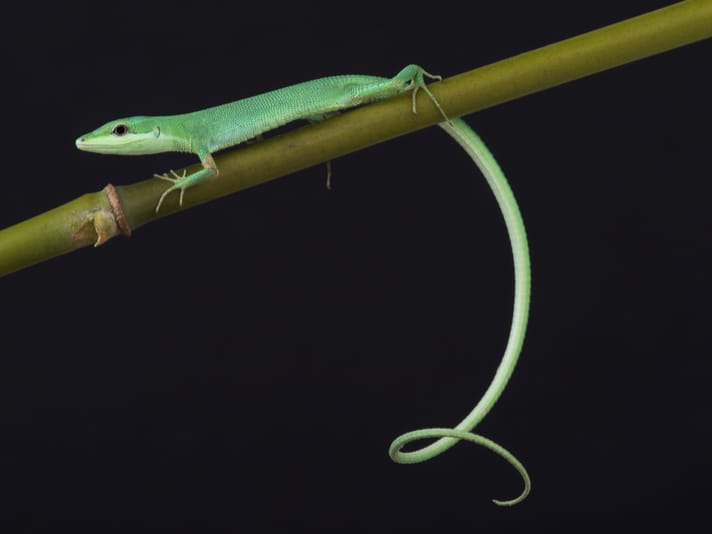The long-tailed and emerald grass lizards are unique and won’t break your bank.
Forty-six years in the field of herpetology can certainly obscure one’s idea of what is interesting and stimulating and what is not. It’s easy, after keeping a great diversity of herps for so many years, to forget about the simple things and focus on what is uncommon or newly available on the market, or to simply concentrate on the latest challenge that the herp trade has to offer. It’s like the old saying, “What you’ve been looking for your entire life may simply have been under your nose the whole time.”
Fortunately for myself, it’s all good! My love for the plain or common species after 41 years of captive husbandry has never waned, and as a result I have always had something available to me that sparks my enthusiasm and holds my interest.

reptiles4all/Shutterstock
The emerald grass lizard (Takydromus smaragdinus) has a long tail, but not as long as that of T. sexlineatus.
Perhaps it was a result of growing up on Cape Cod in Massachusetts, with its overabundance of eastern garter snakes, green snakes, black racers and brown snakes, that I should appreciate the seemingly “insignificant” species. I have learned through my experiences that there are actually no boring or non-thought-provoking herps out there. All of the planet’s herps have something valuable and rewarding to offer.
For many years as a child, I would wander in and out of pet stores, trying to catch a glimpse of the magnificent, cold-blooded creatures that I had only known from books — herps that were out of reach for me but nonetheless still intriguing and leaving me fueled with the passion that would spark my life-long career. It was within the pet stores that I would frequently just sit and watch the lizards while marveling at their intricate beauty and their animated grace. Of all the herps I may have encountered in my travels, the lizards would catch my attention most, because they were the ones that were furthest from my grasp. Lizards do not exist naturally in Massachusetts, so any “hands-on” experience I could obtain would have to come from the lizards that were available to me through the shops.
One such lizard that was, and is, often available is the somewhat peculiar long-tailed grass lizard. In a pet shop, it can be easy to overlook this rather plain-looking, small-bodied lizard among the brightly colored green anoles, leopard geckos and bearded dragons that are so popular among hobbyists today. Were it not for the long-tailed grass lizards’ unnaturally long tails, they may never have made it into the pet trade to begin with.
I have learned through the years to never ignore what appears without charm, because there is great shine that comes from within a rough diamond, a beautiful flower can be hidden among the weeds. And in a way, this is also true of the interesting grass lizards.
Takydromus Taxonomy
Takydromus, the genus to which the grass lizards belong, is known from areas as far north as the Amur region of Russia, south throughout eastern Asia and into south China, Thailand and Indonesia. The lizards are additionally found in Taiwan, Korea and Japan and occupy a multitude of small islands throughout this range.
First described by French zoologist Francois Marie Daudin in 1802, the Takydromus (Greek for “speed runner”) genus belongs to the subfamily Lacertidae and contains as many as 22 species. These include T. amurensis, T. dorsalis, T. formosanus, T. hani, T. haughtonianus, T. hsuehshanensis, T.intermedius, T. khasiensis, T. kuehnei, T. luyeanus, T. madaensis, T. sauteri, T. septentrionalis, T. sexlineatus, T. sikkimensis, T. smaragdinus, T. stejnegeri, T. sylvaticus, T. tachydromoides, T. toyamai, T. viridapunctatus and T. wolteri.

reptiles4all/Shutterstock
The long-tailed grass lizard is an inexpensive pet that will live for about five or six years in captivity.
Most species of Takydromus are relatively unknown and unavailable to the average hobbyist. At least one — T. toyamai, the Miyako grass lizard — is considered critically endangered and has only been recorded on two islands within the Ryuku archipelago of Japan.
Takydromus Natural History
This article will concentrate on the well-known and most readily available grass lizards, T. sexlineatus and T. smaragdinus. They’re rather small and slender, and rarely reach 10 to 12 inches in length. And at least 8 of those inches are taken up by the tail! They are relatively short lived, with a lifespan of about five or six years in captivity.

BC16/Shutterstock
Adult male Takydromus sexlineatus.
Takydromas sexlineatus, commonly called the long-tailed grass lizard (as well as the Oriental racer and Oriental six-lined runner), exhibits a rather plain, reddish-brown to olive green color dorsally. At first glance, it bears a striking resemblance to the American eastern ribbon snake (T. sauritus). It will also typically sport an additional shade of white, green, beige or yellow along the flanks and belly with occasional dark brown to black striping and lighter spotting along the dorsum and or flanks.
Its common name of emerald or green grass lizard indicates the coloration of T. smaragdinus. Its tail is typically only twice the length of snout to vent as opposed to four or five times the snout-to-vent length of T. sexlineatus. Colorwise, T. smaragdinus tends toward a more uniform, two-toned effect such as olive green to a lighter lime green in the anterior dorsum and a solid brown from the pelvic region to the tail tip. An immaculate white, lateral stripe is present in females and has little to no fluctuation in shade as can be found in T. sexlineatus. The ventral scales of T. smaragdinus are keeled only along the sides, and lamellae are present on the toes. Adult female T. smaragdinus are a uniform light green all over. Hatchlings and smaller juveniles tend to sport a green anterior body and a brown pelvic area and tail, and at a quick glance, T smaragdinus resembles a snake, too; this time, a small Asian vine snake (Ahaetulla spp.).
The dorsal scales of both T. sexlineatus and T. smaragdinus are heavily keeled and rectangular in shape, as are the ventral scales, while the lateral scales are small and granular.
Some sexual dimorphism has been considered but not necessarily substantiated in T. sexlineatus, such as a thicker tail in males and a white to cream/beige lateral color in females as opposed to the yellow or green lateral color in males. Males also present with one to five larger, femoral pores. Sexual dimorphism has been recognized in T. smaragdinus, as males are typically a darker green with a brown lateral stripe, and females tend toward a uniform, lighter green with a white to cream-colored lateral stripe. Either gender may exhibit shades of blue in lieu of the green.
Most species of Takydromus are terrestrial in nature, though some, including T. smaragdinus, occupy foliage, and still others live an arboreal lifestyle in the treetops. The long-tailed and emerald grass lizards occupy open, overgrown, damp grasslands at the edges of forests, in which they utilize their long tails for balance and weight distribution while moving swiftly, or “swimming,” across the top of the tall grass. Both species are diurnal and spend their days in search of small invertebrate prey, which they quickly overcome using speed and agility during an attack.
Captive Care For T. sexlineatus and T. smaragdinus
Both T. sexlineatus and T. smaragdinus have become increasingly popular with hobbyists in America and abroad, and are seen with greater frequency in the pet stores and at herp expos. They are rather inexpensive to buy at about $10 to $15, and will do very well in captivity as long as some basic husbandry rules are followed while caring for them.
It’s no secret that grass lizards like to move and do so very quickly. Rapid movements help them to secure prey and avoid being eaten by predators. Therefore, the more space you can provide for these lizards, the more content they will be. Although a pair may thrive in a 20-gallon terrarium, a 40-gallon would be even better, and still larger for multiple specimens.
These lizards are very quick and escape easily when care is not given to captive environment security. A screen cover with clips to secure it will not only keep your lizards in the enclosure, but will keep unwanted hands and pets out. A screen cover also allows for good air circulation, and the beneificial rays of overhead full-spectrum lighting will be able to reach your lizards rather than filtered out while passing through a glass cover.
Neither long-tailed or emerald grass lizards are particularly territorial, and they do well when kept with others of their own species. They can also be kept in a communal terrarium with lizards such as green anoles (Anolis carolinensis) and house geckos (Hemidactylus frenatus) of similar size.
Handle Carefully, Or Don’t
Although long-tailed and emerald grass lizards are mild mannered, great care should be taken if you feel the need to handle either. Although a bite would be virtually painless to the handler, tail autotomy (dropping of the tail) can occur if the lizards are handled roughly or while they’re thrashing about in your hands.
Although a dropped tail will regenerate, it is never quite as nice looking as the original, and it will be some time before another tail develops. When feeling frightened and even during times of excitement such as prior to pouncing on a food item, grass lizards may twitch and or thrash their tails about.
As with any animal, adult supervision should always be provided when young children are observing and handling pets. Excited children may squeeze a squirmy grass lizard too hard or drop it while managing the rush of excitement.
Hygiene should be monitored as well. Washing your child’s hands as well as your own before and after handling lizards will help to prevent unwanted germs from moving back and forth to either party.
Grass Lizard Humidity And Substrate
Takydromus sexlineatus and T. smaragdinus prefer a damp, but not wet, environment which can be maintained with a substrate of peat moss and/or ground bark mulch (various types, including fir, are available where reptile supplies are sold). A humidity level of about 70 to 80 percent is preferable, which can be maintained by misting the inside of the enclosure daily. Misting also allows the lizards to drink water droplets freely as they would in nature. A small water bowl should still be added to the enclosure, however, to ensure your animals stay hydrated.
Grass lizards are always moving and use a lot of energy when kept at temperatures of 75 to 90 degrees Fahrenheit during the day and slightly cooler at night.
Although T. sexlineatus spends most of the time on the ground, individuals do occasionally, like T. smaragdinus, spend time off the ground. Both grass lizards should be provided with a great deal of foliage (artificial or live) for climbing, hiding and foraging for food. In nature, these agile lizards jump and twist sharply while leaping about from grass stem to grass stem, making it difficult for predators to track their movements with accuracy. Hide areas along the substrate, such as pieces of cork bark, will often be utilized by your lizards while sleeping at night.
A day/night cycle should be provided for these diurnal lizards in the form of a full-spectrum, UVA/UVB light during the day, and an ultraviolet (black) light can be used for a few hours at night.
Grass Lizard Food
Because they are active animals, grass lizards should be willing to feed daily, even if only small amounts of food are provided. Small, soft-bodied invertebrates are preferable food items and may include small crickets, wingless fruit flies, waxworms, moths and small spiders. Small, live fish are sometimes taken by these aggressive feeders, as well.
Although mealworms will be taken, I personally prefer not to use them with smaller lizards because of the mealworm’s hard, chitinous outer shell, which may be difficult for some smaller herps to digest.
Much has been discussed in the world of herpetoculture about nutrition and vitamins. Although some species may benefit under certain circumstances from added vitamins and calcium to food items, I generally prefer not to offer these. I prefer, instead, to offer a diet as close to natural as possible, with the addition of full-spectrum lighting and gut-loading my feeder insects with a healthy diet prior to their being fed to my animals.
Breeding Long-tailed Grass Lizards
In captivity, breeding of the long-tailed grass lizard seems to occur randomly and without great effort on the keeper’s behalf. Animals maintained well and kept in proper enclosures with adequate food and water will often breed throughout the year, with one to 10 tiny eggs being laid within the substrate or beneath cage décor. Several clutches of eggs may be deposited over the course of a year.
Mating occurs with the male tracking a receptive female’s every move until he ultimately catches her. He will then latch onto her around her mid-section while immobilizing her with his feet and tail, at which time copulation commences.
A successful breeding will result in eggs being laid about two to three weeks after copulation. The eggs are not adherent and are easily removed, if necessary. Eggs incubated at 75 to 80 degrees should hatch after about 90 days.
Juvenile specimens of T. sexlineatus and T. smaragdinus typically hatch out in a uniform shade of brown, developing color with age. Because of their voracious appetites for virtually anything that moves, neonatal grass lizards should be removed from the presence of adult specimens as quickly as possible. Separating the juveniles will also allow the keeper to observe the tiny lizards for ailments and to monitor care needs.
Juvenile lizards should be fed size-appropriate live invertebrates, such as pinhead crickets and tiny fruit flies. Water can be provided by gently misting the sides of the lizards’ enclosure.
I have kept everything from large anacondas and red-backed salamanders to American alligators and African spurred tortoises. And no matter how big or how small, no matter how “bland” or intense the appearance of an animal, or how seemingly insignificant something seems to be, it is always worth trying something new. There are always new, peculiar habits and behaviors that make each animal unique and well worth the challenge, no matter how small or innocuous. Do your research ahead of obtaining specimens and you will benefit largely, as will your animals. Reading lots of different articles and finding common ground between them, will help ensure your successful husbandry methods.
Leo Spinner is a native of Cape Cod in Massachusetts and is owner/operator of The Spotted Turtle Herpetological Institute (thespottedturtle.net) and Skin & Scales exotic animal presentations of New England.


